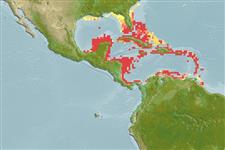Environment: milieu / climate zone / depth range / distribution range
Ecologie
marien rifbewoner; diepte 0 - 40 m (Ref. 9710). Tropical; 33°N - 7°N, 96°W - 58°W
Western Atlantic: Bermuda and southern Florida, USA to northern South America; throughout the Caribbean (Ref. 13442). Including Antilles (Ref. 26938).
Grootte / Gewicht / Leeftijd
Maturity: Lm ? range ? - ? cm
Max length : 29.0 cm FL mannelijk / geslacht onbekend; (Ref. 6937)
Dorsale stekels (totaal) : 10; Dorsale zachte stralen (totaal) : 12. Snout long and pointed. Black stripes and bars forming irregular rectangles on body. Has unique pointed snout and distinct color pattern make it easy to identify (Ref. 26938).
Most common in areas with rock or scattered coral. Solitary or in pairs. Feeds mainly upon crustaceans (Ref. 5521). Synchronously hermaphroditic. The most common member of the genus (Ref. 9710).
Levenscyclus en paargedrag
Maturiteit | Voortplanting | Paaien | Eieren | Fecunditeit | Larven
Displays facultative monogamy where males are constrained to mate with a single female due to resource limitation (Ref. 52884). Pelagic spawner (Ref. 32216).
Robins, C.R. and G.C. Ray, 1986. A field guide to Atlantic coast fishes of North America. Houghton Mifflin Company, Boston, U.S.A. 354 p. (Ref. 7251)
Status op de Rode Lijst van het IUCN (Ref. 130435: Version 2024-2)
Gevaar voor de mens
Harmless
Gebruik door de mens
Visserij: commercieel; Aquarium: Commercieel
Tools
Speciale rapporten
Download XML
Internetbronnen
Estimates based on models
Preferred temperature (Ref.
123201): 25.3 - 28.1, mean 27.1 °C (based on 138 cells).
Fylogenetische diversiteitsindex (Ref.
82804): PD
50 = 0.5000 [Uniqueness, from 0.5 = low to 2.0 = high].
Bayesian length-weight: a=0.01023 (0.00609 - 0.01719), b=3.04 (2.89 - 3.19), in cm total length, based on LWR estimates for this species & Genus-body shape (Ref.
93245).
Trofisch niveau (Ref.
69278): 3.5 ±0.37 se; based on food items.
Weerstandsvermogen (Ref.
120179): Gemiddeld, minimale populatieverdubbelingstijd 1,4-4,4 jaar (Preliminary K or Fecundity.).
Fishing Vulnerability (Ref.
59153): Low vulnerability (22 of 100).
Nutrients (Ref.
124155): Calcium = 50.5 [31.2, 89.5] mg/100g; Iron = 0.572 [0.316, 0.948] mg/100g; Protein = 18.4 [16.6, 20.0] %; Omega3 = 0.148 [0.100, 0.221] g/100g; Selenium = 28.3 [18.0, 49.0] μg/100g; VitaminA = 112 [41, 346] μg/100g; Zinc = 1.29 [0.90, 1.80] mg/100g (wet weight);
